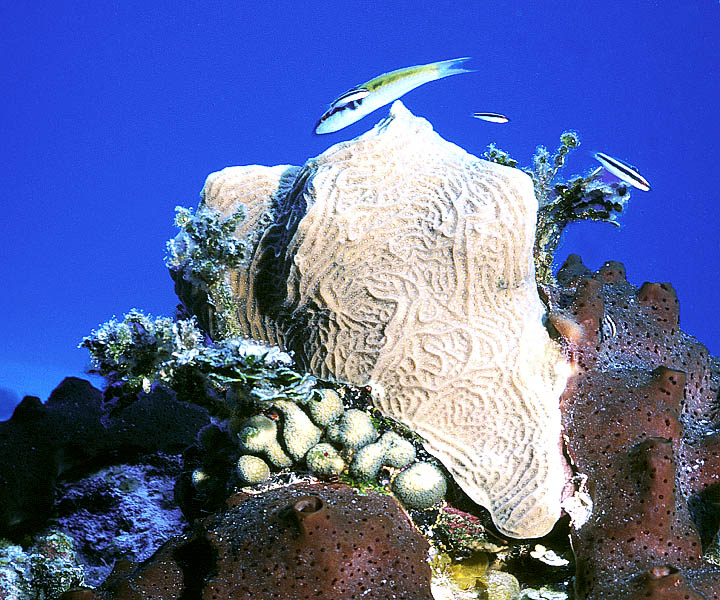
Volume 4 Number 10
Wrasse swim above a Lettuce Coral Reef
at San Salvador, The Bahamas


Volume 4 Number 10
Wrasse swim above a Lettuce Coral Reef
at San Salvador, The Bahamas

This little section of reef shows a healthy colony of Lettuce Coral. The coral is surrounded by sponges, and several Wrasse are swimming nearby.
Lettuce Corals are identified by the large number of interconnected ridges across the colony. Lettuce Corals are similar in many ways to Brain Corals. The coral polyps live in depressions between the ridges. During the day, the polyps hide their tentacles along grooves at the sides of the ridges. Like other stony corals, Lettuce Coral polyps build a strong skeleton of calcium-based minerals and then live in a group on the surface of that skeleton. You can see the individual animals, called polyps, as dots on the surface of the coral between the ridges.
Two large colonies of brown sponges are on either side of the Lettuce Coral. Sponges are colonies of thousands of microscopic animals that pump water through the colony to filter their food from the seawater. You can see the "exhaust pipes," called excurrent pores, where the pumped water leaves the body of the sponge. The excurrent poles are small holes scattered across the sponge.
Learn more about corals and sponges on the ReefNews website, at the ReefNews Index of Corals.
Swimming overhead are four small fish called Wrasse. These yellow-and-black striped fish are called Blueheaded Wrasse. Although none of these fish have blue heads, their heads will change color to a bright blue as they get older. Blueheaded Wrasse often live together in a school, so it is not unusual to see different ages of these fish swimming together. You might think of the three smallest fish as babies and the larger fish as a "teenager," although these fish probably aren't more than a couple of years old.
--------------------
e-ReefNews and embedded illustrations are
Copyright © 2003, ReefNews, Inc.
ReefNews ® is a registered trademark of ReefNews, Inc.